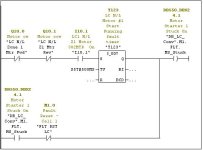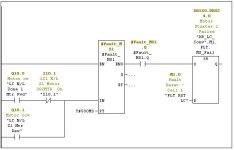Ok, with the help of other here I am getting pretty good with the use of SFB's. I do have a simple question though. In the attached picture you can see an example of logic with an S_ODT that I need to repeat 21 times. Is there a way to use a -(S)- on the Q of a TON, or to insert it in the middle of the network to allow a branch around it for the seal circuit?
Or would the only way to be to use a memory bit on the Q and add a second network?

Or would the only way to be to use a memory bit on the Q and add a second network?







